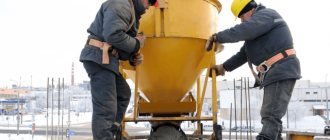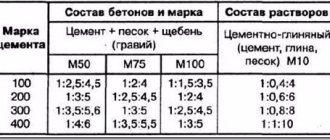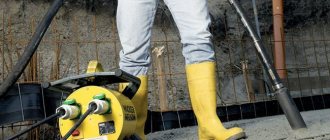Home |GOSTs and SNiP |SNiP 3.03.01-87. Load-bearing and enclosing structures. Concrete works
Date: November 29, 2017
Comments: 0
The implementation of construction activities for the construction of any objects is inextricably linked with the production of concrete work. They are carried out when pouring screeds, erecting foundations, constructing blind areas, and constructing monolithic structures. According to the provisions of the current SNiP, concrete work is carried out with certain grades of concrete in accordance with the approved algorithm. This guarantees the strength and stability of the structures being built, as well as a long service life. Let's take a closer look at the main provisions of building codes.
SNiP for concrete work - main provisions and structure of the standard
The building codes and regulations, approved in 1987 and registered under number 3.03.01, are the main regulatory document that regulates the requirements for the production of concrete work. For example, according to the document, concreting should be carried out from pre-sifted components, which are dosed by weight. The rules require that the components be introduced into the solution in a strict order and mixed for a certain time.
The general structure of the rules is quite voluminous and covers a range of issues:
- requirements for materials used for solutions;
- recommendations for dosing components when mixing;
- methods of laying concrete on various types of foundations;
- features of surface protection and care of hardening concrete;
- testing methodology for the hardened mass at the acceptance stage;
- specifics of concreting at different temperatures;
- requirements for concrete reinforcement and formwork construction;
- methods for quality control of concrete-based structures.
When constructing any construction project, it is impossible to do without concrete work.
When developing a work project, it reflects all types of activities that must be carried out in accordance with the requirements of building codes. Deviations from the provisions regulated by the rules reduce the quality of concrete measures and affect the safety of structures and durability. Let's consider the main provisions of the main sections of the regulatory document.
Laying concrete in different weather conditions
The technology for laying concrete depends on the weather conditions and the season in which it is carried out. Let's look at how concrete should be poured in hot, cool weather and sub-zero temperatures.
Laying concrete in the heat
The main difficulty of this process is that high temperature and low humidity of the surrounding air lead to excessively rapid hardening of concrete. This negatively affects the strength characteristics of artificial stone and structures made from it. Therefore, pouring concrete in hot weather must be carried out with strict adherence to the order and timing of the stages of the technological process.
When pouring concrete in hot weather, the following requirements must be met:
- Use good waterproofing. The requirement must be met even when the structure being created, according to the design, is not waterproof. This is done to prevent moisture from the concrete from being absorbed into the soil. Thanks to this, the solution gradually hardens.
- Prompt unloading of concrete from a concrete mixer (concrete truck). It has sufficient frost resistance, which makes it widely in demand for creating facilities operated in variable climate conditions. This type of concrete is characterized by endurance and durability.
- Effective organization of concrete supplies in the case of using several concrete mixers. In such conditions, it is necessary to coordinate the arrival time of concrete trucks so that they do not stand idle waiting for unloading. Such forethought will make the construction process uniform and continuous, and it also ensures the preservation of the high quality of concrete used in the work.
Placing concrete in cool weather and rain
The weather is characterized by low temperatures and high humidity. Such conditions lead to the fact that the poured solution hardens much longer than at optimal humidity and temperature parameters. Therefore, builders are forced to wait quite a long time before starting to grout the concrete surface. This does not deteriorate the quality of concrete structures, but significantly increases the time for construction and finishing operations.
Pouring concrete in wet and cool weather should be carried out taking into account the following requirements:
- Concrete waterproofing should only be used if required by the project. To speed up the hardening process of concrete, waterproofing should not be used at all, especially when concreting inclined surfaces.
- Concrete moisture should not be excessive. To protect the surface of the mixture from rain, it should be protected with a canopy or special film.
- Pouring the foundation with concrete layer by layer must be carried out in a timely manner.
Pouring concrete in cold weather
There are special rules for carrying out concrete work in winter conditions. Concrete has an important property. As the concrete hardens, the temperature increases. Heat is released as a result of the so-called exothermic reaction between cement and water. This valuable property of the concrete mixture helps builders protect concrete from rapid freezing.
At negative temperatures, the hardening process of the concrete mixture is disrupted: the water in it freezes and turns into ice, normal interaction between cement and water does not occur, which means the amount of heat generated by the cement during hardening is reduced. When frozen concrete is warmed up, the hardening process resumes, but still the strength of the concrete decreases slightly.
In order for concrete to withstand the damaging effects of frost, it must reach 50% of its design strength before freezing. Then the grains of the fillers will be firmly attached to each other, and when water turns into ice, it will not be able to tear them away from each other.
When concreting and further hardening of concrete, it is necessary to maintain a constant positive temperature of the external environment until the required strength is achieved. To prevent freezing of the concrete mixture and create normal conditions for its hardening, various methods of winter concreting are used. The thermos method, steam heating, electric heating, and portable heat guns have become widespread. Concrete must be delivered to the work site warm, and the sand and crushed stone cushion must not be frozen.
When making a concrete mixture, it is necessary to use warm water and inert materials heated to positive temperatures. Using the UBRS-10, UBRS-40 installations in the “winter version” configuration for concrete production in winter allows you to avoid many problems and obtain guaranteed quality construction mixtures.
SNiP requirements for concrete work - preparation of solutions
To prepare a high-quality composition in accordance with building codes, various types of solutions are used, the aggregates of which have a certain size and are pre-cleaned of impurities.
Be sure to comply with the following requirements:
- dosage of ingredients is carried out by weighing;
- adjust the proportions of components for different batches of cement;
- make, if necessary, changes to the recipe when mixing;
- adhere to the recommended order of loading components;
- deliver ready-made concrete to the construction site using special transport.
It is important to follow the following order of loading components into the concrete mixer:
- at the beginning of mixing, pour in the required volume of water and add sand;
- then add crushed filler and cement into the running mixer.
Mix the ingredients until smooth. It is forbidden to dilute the prepared solution with water to increase the mobility of the mixture.
The brand and type of cement and filler used to prepare the solution determine the purpose and scope of its application.
Compacting poured concrete
During the process of mixing in a concrete mixer and pouring, the concrete solution is saturated with air bubbles. In addition, during operation such material may lose its uniformity. To eliminate these shortcomings, special devices are used for compacting concrete - vibrators. They affect the poured mixture with vibration, which leads to the removal of air bubbles and voids from the thickness of the concrete. Vibration also contributes to the uniform distribution of material particles throughout its thickness, which gives the concrete solidity and homogeneity.
How to lay concrete mixture SNiP 3.03.01
To ensure the required strength properties of the monolith, concrete must be laid correctly. SNiP contains requirements for preparing the foundation. This could be a foundation pit or a regular site. It is necessary to clear the area of construction debris, cement residues, dirt, as well as protruding tree roots and vegetation.
SNiP also contains recommendations on how to carry out concreting on a prepared base. It is important to observe the following points:
- lay the solution in a horizontal layer of equal thickness;
- avoid breaks when pouring the concrete mixture;
- compact the massif without resting the vibrating tool on the reinforcement frame;
- ensure the immobility of the formwork when compacting the solution;
- lay the next layer of concrete before the previous one begins to harden;
- maintain a distance of 5–7 cm from the plane of the solution to the top of the formwork;
- perform construction seams on the surface according to the requirements of the project.
When pouring, the height of dropping the mortar into the formwork must be observed, as well as the thickness of each layer being poured.
CURTINING AND CARE OF CONCRETE
2.15. During the initial period of hardening, concrete must be protected from precipitation or moisture loss, and subsequently maintain temperature and humidity conditions to create conditions that ensure an increase in its strength.
2.16. Concrete care measures
, the order and timing of their implementation, control over their implementation and the timing of dismantling of structures should be established by the PPR.
2.17. Movement of people on concreted structures and installation of formwork on overlying structures is allowed after the concrete reaches a strength of at least 1.5 MPa.
TESTING OF CONCRETE DURING ACCEPTANCE OF STRUCTURES
2.18. Strength, frost resistance, density, water resistance, deformability, as well as other indicators established by the project, should be determined in accordance with the requirements of current state standards.
What kind of concrete work is carried out in construction according to SNiP?
Building codes classify the performance of concrete work. Main types:
- preparing the solution;
- pouring concrete;
- array compaction;
- construction of the foundation;
- construction of walls;
- construction of columns;
- concreting screed;
- care of hardening material.
Each type of work, according to SNiP, has a number of features
Additional types of construction activities associated with concreting include:
- construction of formwork;
- production of reinforcement frames.
Depending on the ambient temperature at which the work is performed, they are divided into the following types:
- winter, carried out at temperatures below zero degrees Celsius;
- spring-autumn, which are performed at normal temperatures;
- summer, produced in hot weather at temperatures above 25 °C.
Care of concrete is determined by the temperature conditions under which concreting was carried out.
Types of vibrators for concrete
Vibrating equipment for concrete compaction is divided into types:
- Deep. Such vibrators are used when it is necessary to process a relatively thick layer of concrete, as well as a mixture poured into a container or formwork with a complex shape. The vibrating tip of the deep vibrator is located on a flexible shaft, which makes it easy to use for processing concrete in remote areas. The tip of such a device is immersed in the concrete to a sufficient depth, which allows the entire volume of the mixture to be thoroughly processed. Using deep vibrators, the concrete mixture is compacted sequentially from one end of the structure to the other. The working tip of the vibrator is immersed vertically or slightly inclined into the concrete mixture, kept there for some time, and then slowly removed and immersed in a nearby place. To better compact the concrete mixture, the working tip of the vibrator immersed in it is slightly raised and lowered (5 - 10 cm) within the concrete layer. The concrete mixture should be compacted especially carefully in places with dense reinforcement, near the walls of the formwork and in all corners. Vibration is stopped when signs of sufficient compaction appear: the mixture settles completely and laitance appears on the surface.
- Superficial. Vibrators of this type are used to compact concrete structures that have a large surface and small thickness, for example, bases for floors, road surface slabs, etc. Vibrators are installed directly on the poured concrete, and the working platform of the vibrator moves along the surface of the laid concrete mixture. By promptly and correctly rearranging the vibrator, all areas of the concrete structure are compacted. The operation of the surface vibrator in one position lasts about 60 seconds (depending on the composition of the mixture and the thickness of the layer). In this case, a lot of skill and experience is required from the concrete worker. Surface vibrators can have different impact diameters and different powers.
- External. The vibrator is attached to the outside of the formwork using bolted joints, a vice or other gripping device. External vibrators are used to compact concrete mixtures when concreting thin vertical or inclined structures. When laying the concrete mixture, an external vibrator transmits vibrations to the concrete through the formwork and compacts it.
Compliance with the sequence of technological operations for pouring concrete provides concrete structures and products with the necessary strength qualities. The technical parameters of concrete mixtures are greatly influenced by the use of modern productive construction equipment: concrete mixers, cement dosing systems, inert materials, water, chemicals. additives and high-quality building materials. Thanks to this, concrete structures acquire the necessary reliability, durability and safety.
Requirements for the quality of concreting
The following requirements are imposed on finished reinforced concrete and concrete structures of all types in accordance with SNiP:
- operational safety;
- serviceability;
- durability;
- additional requirements specified in the design documentation.
The quality of the finished structure depends on the quality of the materials used and compliance with technological regulations at all stages of construction. In order to ensure that SNiP requirements are met, control is carried out at all stages of concreting:
- acceptance/storage of building materials;
- execution and installation of reinforcement structures;
- production and installation of formwork;
- preparatory measures for the base and formwork surfaces for concreting;
- the process of preparing and transporting concrete mixture;
- work on laying and compacting the mortar, as well as caring for it during hardening.
During the preparation of a concrete mixture, the accuracy of the dosage of components, the duration of the mixing process, as well as the density and plasticity of the mixture are checked. During transportation, the mixture should not separate, set or lose mobility.
At the reinforcement , in addition to the quality of the reinforcing bars, the quality of welding connections and the correct placement of reinforcement in the structure are checked. When constructing formwork, special attention is required to the correctness of its installation, the tightness of butt joints, as well as the location of the formwork relative to the reinforcement structure.
Before directly laying the mortar , the quality of the lubricant and the cleanliness of the formwork surfaces must be checked; during the laying process, the height from which the mixture is dropped, the duration and uniformity of compaction are strictly observed. The presence of voids and delamination is strictly unacceptable.
Concrete work carried out in winter requires special control measures. During their production, the absence of ice when feeding unheated aggregates into the concrete mixer, the temperature of the supplied water, the concentration of salts and the temperature of the solution at the outlet of the mixer are checked.
Prefabricated strip foundation
The construction of this type of foundation is carried out from concrete or stone blocks made in the factory or independently. At individual development sites, blocks of various types of foam concrete are often used for this purpose. The reduced weight of such building structures allows the use of a compacted bedding made of sand and crushed stone as a support cushion. Concrete preparation is used only for large, heavy buildings. The technology for performing the work is similar to the preparation device for monolithic structures.
Scheme of the device on a sand bed
The thickness of the preparation layers depends on the type of soil and the total weight load of the house. For dense types of soil, a thickness of 100-150 mm is sufficient. For softer or moist soil, the concrete layer must be increased. A cushion of sand and crushed stone of at least 15 cm. To compact it, you can use a hand tamper or spill it with water.
Diagram of the device on a crushed stone cushion
The preparation device for a prefabricated strip foundation allows for stage-by-stage execution of work with interruptions, which is impossible when installing reinforced concrete monolithic structures.










